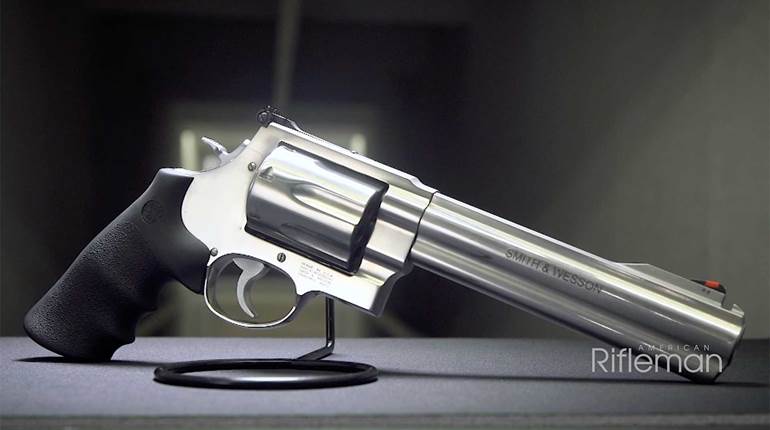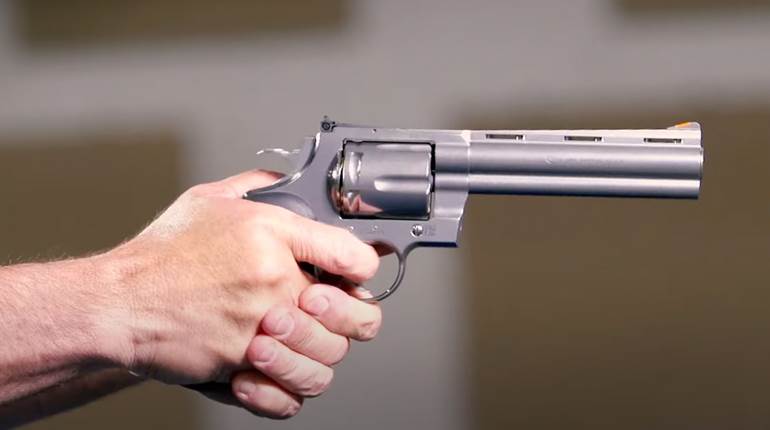
Throughout its storied history Smith & Wesson has repeatedly been at the forefront of innovation.
S&W is the company that gave us—among other things—the .38 Spl., the .357 Mag. (both the revolver and the cartridge), the Combat Masterpiece, stainless steel as a gun material, Scandium as a gun material, as well as the .44, .460 and .500 Magnum revolvers. Clearly the company and its succession of leaders is of the “thrive-on-competition” ilk. A few years ago, I had the honor and pleasure of taking a plant tour of Smith & Wesson, and I came away amazed and awed at its ability to seamlessly meld 19th, 20th and 21st century technology into a remarkably efficient manufacturing process.
When it announced the new Bodyguard series of self-defense handguns—a pocket .380 semi-auto and a five-shot, .38 Spl. +P revolver—I saw the revolver and thought, So what? It’s just a repackaged Model 40 Centennial. However, Paul Pluff, of Smith & Wesson, told us at the announcement that the Bodyguard revolver may look like a traditional J-frame, but its insides are completely different. “In fact,” he said, “there isn’t a single interchangeable part between the Bodyguard and a J-Frame.”
As it normally happens, it’s a few months from the announcement until we can get a shootable sample for review. Mine arrived on a sultry, late-August afternoon as I was planting fence posts. When the small, adult-signature-required box arrived, my dirty, sweaty paws were only too happy to break off from fence building for some quality gun-fondling time.
I own a couple of J-Frames, a Model 60 and a Model 340PD, so I dragged them out for comparison. The first thing any Smith aficionado will notice is that the cylinder turns backward. By that I mean that it turns clockwise. Opening the cylinder and inspecting the recoil shield, I noticed a couple of things: There is no window where the hand would come out to rotate the cylinder, and the ratchet looks different. Instead of the normal oblong ratcheting lugs found on the ejector star, the Bodyguard 38 has something of a star-like recess that engages a male counterpart through a hole on the recoil shield. I see a couple of advantages here. With no opening in the recoil shield there is almost no probability that dirt, grit or pocket lint can get into the lockwork and muck it up. Don’t laugh. When I opened up my Model 60 there were some tiny whisps of pocket lint polluting the inner sanctum of the revolver, no doubt a result of the years that little gat has spent lounging in various pockets of my clothing. Secondly, assuming that at least part of each star is engaging the recess on the cylinder; that means there is a larger area of contact to distribute rotating force, as well as withstanding firing forces. The advantage there is durability and reliability, and considering that this revolver weighs in at a dainty 14.5 ounces and is slated for +P ammo, extra durability is a nice thing to have.
Dimensionally, there are nominal differences between the J-Frames and the Bodyguard 38, largely unnoticeable in terms of feel of the gun in the hand. The Bodyguard comes with a rubber-like grip that is almost sticky in the hand, and it helps attenuate the recoil of +P loads well.
I had to take a peek inside. Over the years I have opened up dozens of Smith & Wesson revolvers, so much so I think I could do it—and probably have—in my sleep. The Bodyguard, however, took a bit longer. Instead of three or four screws to pop the sideplate, it has five screws—three on right side, two on the left—and the polymer grip/trigger guard slides off the aluminum-alloy frame. Actually, it’s a bit retro by removing the grip from the frame a la single-action revolvers. In the interest of full disclosure, I did not tear down the Bodyguard 38 to individual parts, just enough to determine the redesign parameters. Combining modern manufacturing techniques and material platforms, it looks as if the engineers in Springfield asked the question, “Why do we still utilize heavy, expensive-to-machine-and-finish metal in a grip?” Where the strength of metal is needed—around the cylinder and to contain the lockwork—metal is employed.
With the thumb-latch mounted at the top of the frame to facilitate ambidexterity, it engages a small piece of bent sheet metal, which, in turn, retracts the male portion of the ratchet, freeing the cylinder to swing out of the frame. The hammer is about a quarter of the mass of a J-Frame hammer, and the coil mainspring is somewhat lighter as well. I am guessing that the engineers are utilizing a quicker locktime—higher hammer velocity—instead of hammer mass to reliably crack primers. The hand operates from the trigger via a connecting rod and engages the ratchet within the lockwork. It appears that the lockwork uses about half the space of a traditional J-Frame gun. Smaller parts, plus the use of composites have allowed Smith & Wesson to produce an extremely lightweight revolver for considerably less money than the expensive Scandium guns.
What at first looks like the barrel coming off the front of the frame is actually an extension of the frame. The extension is a shroud for the barrel-proper and the ejector rod. So it’s probably not a good idea to clamp what looks like the barrel in a vise and try to wind it off the frame with a piece of hardwood in the cylinder window. Remember that with the Bodyguard the only similarity to previous Smith & Wesson revolvers is the overall profile. This puppy is a whole new design.
Another cutting-edge feature on the Bodyguard series is the factory-supplied laser sighting system from Insight Technology. Before testing this gun, I had only casually played with laser sights. I am now a believer. My groups with the laser were half the size of those utilizing the integral fixed sights. Those fixed sights, by the way, need some adjustments. Either the front blade is too wide or the rear notch needs to be opened up a bit. This is a combat gun, not a target pistol, so finely tuned sights with hair-like narrow gaps are more of a liability. On my personal Smiths, I have narrowed the front sight to about .100-inch, which makes it far quicker to pick up. The laser sight, though somewhat slower to deploy than those mounted in the grip, is diminutive enough to be unobtrusive on the revolver. It can be removed for a battery change, and it can be adjusted for windage and elevation with the pair of Allen wrenches included with the gun. A caveat: Find a way to absolutely secure those wrenches. They are incredibly small and can be very easy to lose. You won’t find replacements at your local hardware store, so take pains to see that you can find them when you need them.
Shooting the pocket gun was actually more pleasant than usual, especially with the Speer 125-grain Gold Dot Hollow Points I prefer in this type of revolver. The rubber grips shielded me from the otherwise stiff bark I receive from this load in my J-Frames. I shot it across my chronograph just to verify, and it averaged 950 fps out of the 1.9-inch barrel. If memory serves me, I get some 1,075 fps from the same load out of a 4-inch barreled Model 19. Groups using the open sights at 10 yards averaged about 2 inches and printed some 3 inches above the point-of-hold, but when I used the laser and shot from belt buckle height at a specific aiming point, my groups shrank to an inch or less.
Smith & Wesson has once again provided real innovation and a better value to the self-defense market. My Model 340PD, which has a very similar profile but no laser, carries an MSRP of $1,153. The Bodyguard 38 with the laser sight is nearly half that at $625. That’s real value to the consumer. Whether as a “Get-Off-Me!” gun or a backup for another carry gun, the Bodyguard 38 gets two thumbs up from me.
Manufacturer: Smith & Wesson; (800) 331-0852; www.smith-wesson.com
Model: Bodyguard 38
Type: Double-action-only revolver
Caliber: .38 Special +P
Barrel Length: 1.9 inches
Capacity: Five rounds
Rifling: 1:18.5 RH
Sights: Fixed metallic and integral laser
Safety: Hammer block
Grip: Rubber
Overall Length: 6.6 inches
Weight: 14.3 ounces
Finish: Black Matte
Accessories: Allen wrenches to adjust and remove laser sight, lock
Suggested Retail Price: $625






































